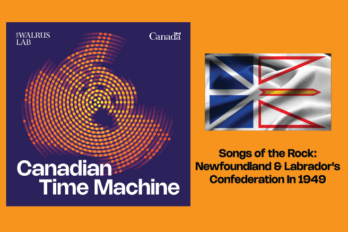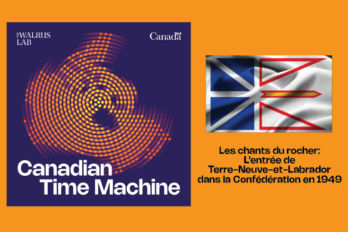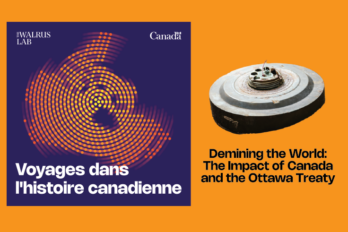SHOW NOTES:
SOURCES USED IN THIS EPISODE
The music for this episode is a licensed version of “This Podcast Theme” by InPlus Music. Additional music are licensed versions of “Stay Cool” by Loops Lab, “Podcast Intro” by InPlus Music, “Both of Us” by Madirfan, “Oh My” by Patrick Patrikios, and “Young Ballad” by Serge Quadrado.
LINKS MENTIONED IN THIS EPISODE:
- How Two Doctors Are Hacking the Transplant System
- When Sports Fans Change the Game
- The Walrus Talks: What’s Next (Toronto)
ADDITIONAL LINKS:
TRANSCRIPT:
SHEENA: We’re back with The Deep Dive, our weekly podcast that takes a deeper look at everything we’re creating at The Walrus. I’m Sheena Rossiter.
ANGELA: And I’m Angela Misri. On this week’s episode:
CLIP FROM INTERVIEW WITH KARIN OLAFSON:
ANGELA: Organ donation is a tricky science. Many factors have to align for a recipient to receive the organ from a donor. And in Canada, with large geographical distances, getting organs to donors becomes even more tricky.
SHEENA: And for the May issue of The Walrus, Karin Olafson takes a look at the complexities of organ donation in Canada. She explains why sometimes donated organs can’t always be used, and why she decided to look into this issue in the first place. She’s a Vancouver-based writer who focuses on health, science, and fitness. Her work has appeared in the Globe and Mail, Chatelaine and Broadview.
ANGELA: Now let’s check out your conversation with Karin Olafson.
SHEENA: For the May issue of The Walrus, you take a Deep Dive into organ donation. Why did you want to write about this topic?
KARIN: Yeah. So for me, this has really been an interest for about 10 years. It’s something I started researching back in 2012. Back in 2012, my best friend died in a sudden tragic accident, and that’s how I learned that she was an organ donor. So she saved five lives, which is everyone told me, you know, it’s a good thing. These are her wishes. She saved five lives. But I really struggled with the concept knowing that she was an organ donor and I had difficulty grappling with that. So what I did, I think was I, I turned to research. I wanted to try to understand organ donation. And I think, I don’t know, maybe research was my way of kind of channeling that grief and trying to make sense of something senseless that it happened. Yeah. So that’s what I did. It was kind of a personal interest, a personal project of mind to start doing that research. And that’s how I learned that there is a shortage of donor organs. You know, people are on wait lists for years, sometimes dying on wait lists and that issue hasn’t been resolved in the past decade. That’s still something we’re seeing. Yeah. So this story for the May issue is a chance for me to dive into a small part of this like really wide complicated issue.
SHEENA: I’m so sorry to hear about the passing of your friend. Is she the person that’s featured in the article in the beginning in the introduction?
KARIN: No, she’s not. I actually, I feel really fortunate to have met so many different people throughout the course of writing this story. So the story that opens this article, I was, I guess, like very grateful to be able to, to speak with her sister who spoke so openly and she was able to share her experience with me. And I spoke with a few other people as well, whose stories didn’t make it into the magazine, but they really were such an important part of, I don’t know this writing journey for me throughout this whole writing process. I was thinking about those personal stories, both the ones in the magazine and my experience and those other people, because this is such a, a human topic. It’s a story about technology. And, but organ donation really is it’s human. You know, it’s about the human tragedies that have happened. And then those human lives that are being saved because of those tragedies, being able to connect with those people and share our experiences and, and talk about that, which I hadn’t really done with many other people. That was also a chance for me to do that during the story.
SHEENA: It is a bit of a silver lining in a way. Obviously some people do manage to have their lives saved when people don’t survive. Is that kind of how you saw it?
KARIN: I think that’s kind of how it was to me back in 2012. I remember speaking with my, my sister and like explaining that I felt like that it was, it was just such a difficult concept for me to grasp. And she had kind of said that, you know, but she saved five lives. This is a good thing. So yeah, it can provide some closure knowing that this is the person’s final wish. Like this is something selfless they’ve decided to do. And also knowing that this one tragedy has prevented tragedies and other families.
SHEENA: It is rather difficult to get an organ donation here in Canada. Can you explain why it’s so difficult and complicated to get an organ donation in Canada in the first place?
KARIN: So for this article I spoke with Dr. Jayan Nagendran, he’s the surgical director of lung transplantation at the University of Alberta hospital and also an associate professor in the department of surgery at University of Alberta in Edmonton. And he explained it to me that it can kind of be boiled down into two challenges. There’s the supply shortage really it’s difficult because there just aren’t enough organs in the donor pool to meet the demand, you know, the demand, the supply isn’t meeting the demand, but it’s also challenging because of the quality of those donor donor, or maybe it makes more sense to say the poor quality of those organs. So it makes it difficult and complicated is because transplantation is, is really a race against the clock, the quality and functioning of donor lungs. And I should say all donor organs, but I focused on the lungs for my research, build it deteriorate over time. So on ice, which is how donor organs are transported. Donor lungs can really only survive six to eight hours. So after 10 hours, there’s irreversible damage. And after 12 hours, those donor lungs can’t be used at all for transplantation, huh? So for a transplantation to be successful, that transportation has to happen really quickly. And so that’s what prevents that damage happening. But that’s also really complicated when you factor in the size of, of Canada.
SHEENA: Well, and it’s not just a question of getting the organs to the people within that allotted amount of time. It’s also a question of matching up the organs in terms of size and things like kidneys, which do have to have a specific match. Can you explain how complicated it is to match donors up with recipients?
KARIN: Yeah, it is complicated. Everything has to perfectly align as well as that timing. So as I mentioned, everything has to happen for lungs within that six to eight hour time window, but as well as considering logistics, your considering biology and the physiology, not just anyone can receive any donor lungs after a, a patient is deemed in need for a lung transplantation, like based on assessment by many, many medical teams, they’re then placed on a list of active patients who need a donor. And then when that offer comes through. So the way this is explained to me by a doctors and Nagendran is that surgeons have to consider things like size, like you said. So for example, a baby couldn’t receive an adult organ, of course, but then there also has to be matching in terms of things like blood type. So a better match means reducing the risk of organ rejection. And that means that rejection is basically a process in which the transplant recipients immune system attacks the transplant implanted organ, and then can’t be used. So that matching makes it really challenging when there is a small donor pool to begin with. Yeah. And then when you’re also thinking about geography in Canada, so for lungs, what’s interesting is that in Canada, there are only four centres that perform lung transplantation, Vancouver, Toronto, Montreal, and then Edmonton, which is where I focused my research and Edmonton is particularly, it faces some really unique challenges because of, of this huge catchment area. This hospital serves all of Northern BC, all the territories, all of Alberta, all of Saskatchewan and all of Manitoba. So in terms of a match, you’re looking at trying to get an organ from within this huge, huge catchment area doctrine. Nagendran explained it to me as representing about 6 million square kilometres.
SHEENA: And what sort of technology is being used to help get these organ donations to recipients at a faster rate? So they don’t expire and they don’t have to get thrown away?
KARIN: I’ll talk a little bit about what’s being used currently when I spoke with Dr. Nagendran, and he’d mentioned to me that the first successful lung transplantation, and, and by that, I mean, the first recipient who survived longer than just a few days or weeks was in Toronto in 1983. And he explained to me that since then there have been like technological advances in terms of the surgical procedures and immunosuppression, but the technology in terms of how that organ is getting from the donor to the recipient really hasn’t changed at all since that time since 83. And that transportation method is just very, very low tech. So what happens now and what happened then is that surgeons travel to the hospital where the donor is. They conduct all their medical assessments and learn how that organ is functioning. Those donor organs are then removed, they’re put plastic bag and placed in a picnic cooler full of ice cubes. Nagendran actually said to me, it’s like the same thing you’d see at a barbecue. And then that’s how they’re moved between facilities. And that’s exactly how it’s done today. What would revolutionise? This is the piece of technology I researched for this story that was created by Dr. Nagendran and a colleague, Dr. Darren Freed, who is a cardiac surgeon at the University of Alberta hospital. It’s called the EVOSS – the Ex-Vivo Organ Support System. It’s basically a piece of technology that perfectly replicates the human body, but it’s obviously outside of the human body. So lungs can live effectively with this piece of technology for up to 48 hours. And it perfectly replicates the human body.
SHEENA: I mean, that sounds pretty amazing that that is helping move the technology we have for organ donation forward to help more people.
KARIN: What’s really amazing is that it’s set to be commercially available here in Canada later this year. It’s this amazing piece of technology that I think when I first heard about it, it’s something that you might think, oh, this will be used years down the road, but no, like this is gonna be commercially available later this year. It perfectly replicates the human bodies. So it has, it provides blood continuously flowing, flowing through the organ. That’s what, uh, the ex vivo perfusion means. But then it’s also the same temperature as our human body, 37.4 ℃ as opposed to ice. And then it also uses negative pressure. So that’s how we breathe naturally. And as opposed to having error forced into our lungs, which can damage the lungs. This machine uses negative pressure, which is basically how our diaphragm works. Now, it contracts, it pulls air in, and that’s how our body works. So because it’s in this prime environment or this environment that replicates the human body, those organs can serve five longer as opposed to when they’re on ice. And there’s also the potential to make organs more viable when they might not have been viable beforehand. So they can effectively be made healthier. The infections can be treated. Clots can be busted up using clot busting medication. They can be made viable when they might not have been previously.
SHEENA: Okay. So this is one technology that’s being used to help with organ donation, transplanting and transportation, but how are some provinces dealing with the organ donation shortage?
KARIN: I think there’s really two ways to, to think about this or two things to talk about right now. So some provinces are working with the short shortage to try to make registration easier and more intuitive because in theory, more registration means more supply. During the course of my research, I came across some interesting data, Canadian blood services, estimates that at least as of the end of 2020, only 32% of people in Canada have registered their decision about donation. But that doesn’t mean that almost 70% of Canadians don’t want to be donors. A poll found that actually 90% of people surveyed about organ donations said they supported it, but 36% of those respondents from that poll said, they didn’t know how to show consent in their own province. So some ways that this is being handled in provinces is to make that easier. So that has meant maybe moving towards an online registration system, as opposed to like mail in or having to register when you renew your driver’s licence. So for example, Saskatchewan launched its online registration system in September, 2020, but what’s really unique. That’s happening in Canada. What’s happening in Nova Scotia in 2021, Nova Scotia became the first jurisdiction in north America to enact a presumed consent policy. Sometimes that’s also called an opt out policy. And what that means is it’s basically assumed that all individuals have given their consent to have their organs donated when they die, unless they specifically opt out. So that’s the opposite of what is used elsewhere in Canada, where you have to like explicitly opt in that being said, there are also a lot of conditions where this doesn’t apply, like people under the age of 19 temporary residents, members of the military, that kind of thing.
SHEENA: There is a surprising thing for some people, even if they do get put on a transplant list and they do wanna donate their organs after they pass on their organs, still can’t be donated after they die. Can you tell us a little bit about that?
KARIN: I think the first thing that’s maybe important to highlight she is that like anyone can register to donate their organs and anyone’s organs can potentially be used. They’re all assessed and evaluated on a case by case basis. So don’t rule yourself out. Don’t like don’t register just because you think you might be too old or because of your health history, for example, the oldest organ donor in Canada, 92 years old, but yes, registering as an organ donor will not guarantee that the organs will then be viable or transplantable after death. What I learned during my research is that so much depends on really on the death and like where it happens and how it happens because that affects the quality of those organ right now, without the EVOS, just the way the system is used right now, transplant doctors will refuse donor lungs with infections like pneumonia or lungs with maybe blood clots or tumours, or if they’ve been really badly damaged, or if they’re filled with fluid, which is what surgeons like doctrine Rin and Dr. Fried call boggy. That’s just because they’re not working well enough. And if they’re not working well, doctors have to be really cautious about transplanting them into someone who’s immunocompromised, cuz that could have a really catastrophic effect. And right now there’s no data telling surgeons how well that organ is functioning between the time that the is removed from the donor and then put into the recipient. That being said, the EVOS could potentially revolutionise that because like I mentioned, this machine, this technology, it provides the ability to make those repairs to the lungs, to administer those antibiotics, to improve the health of the, as organs outside of the body and really make them transplantable or more viable, which yeah. That could improve the number of, of organs that are within the donor pool. So I’m currently reading lost in the valley of death actually by a Wal editor Harley Rustad. I am really fascinated by these stories of people that, that go missing without a trace. When I found that this book written by a Canadian was just published, I was really interested to read in to learn more about this story. I’ve only just delved into it, but I’m excited to see how it ends.
SHEENA: Let’s find out what Karin is reading right now:
KARIN OLAFSON:
JASON HERTERICH:
I’m Jason Herterich, and here’s what we’ve been talking about this week at The Walrus.
As always, the links for all these articles can be found in the show notes for this episode.
CREDITS
ANGELA MISRI:
Thanks for joining us on this week’s episode of the Deep Dive. It was produced by myself, and Sheena Rossiter and I edited this episode with a little help from Ally Baker and Jason Herterich who found me some wicked stings.
Thanks so much to Karin Olafson for joining us this week.
Music for this podcast is provided by Audio Jungle. Our theme song is This Podcast Theme by Inplus Music. Additional music is Stay Cool by Loops Lab, Podcast Intro by Inplus Music, “Young Ballad” by SergeQuadrado; “Screen Saver” and “Comfortable Mystery” by Kevin MacLeod.
Screen Saver by Kevin MacLeod
Link: https://incompetech.filmmusic.io/song/5715-screen-saver
License: https://filmmusic.io/standard-license
Comfortable Mystery by Kevin MacLeod
Link: https://incompetech.filmmusic.io/song/3531-comfortable-mystery
License: https://filmmusic.io/standard-license
Don’t forget to subscribe to Deep Dive from The Walrus on Apple Podcasts, Spotify, or wherever you get your podcasts. And if you like what you heard, please leave us a review and rating. It really helps people find the podcast.
See you next week when we take our next deep dive.









